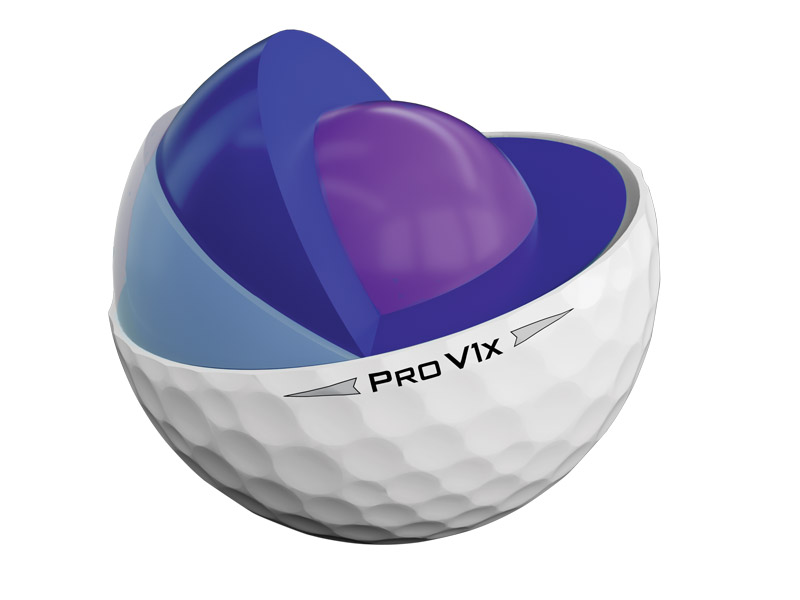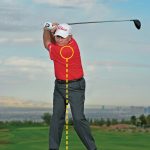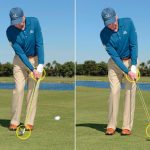A golf ball contains a core, mantle, and cover. These components work together to influence performance and feel.
Golf balls are meticulously engineered to enhance play. The core, typically made of rubber or synthetic materials, determines the ball’s compression and distance. Surrounding the core is the mantle, which adds control and reduces spin. The outermost cover, often made of urethane or Surlyn, affects durability and feel.
Each layer plays a crucial role in how the ball responds to a golfer’s swing. Different golf balls are designed for varying skill levels and playing styles. Understanding the composition helps golfers choose the right ball for optimal performance.
Introduction To Golf Balls
Golf balls are a marvel of engineering. They have evolved significantly over the years. Each layer and material inside contributes to its performance. Understanding these components helps golfers appreciate the game better. Let’s dive into the history and evolution of golf balls.
Brief History
The first golf balls were made of wood. They were used in the 14th century. These balls were heavy and did not fly far. In the 17th century, featherie balls were introduced. They were made from leather and stuffed with feathers. This made them lighter and more aerodynamic.
By the mid-19th century, the gutta-percha ball became popular. Made from tree sap, it was cheaper and more durable. This ball revolutionized the game, allowing for longer shots and better control.
Evolution Over Time
In the early 20th century, rubber-core balls were developed. This marked a significant advancement in golf ball technology. The new design featured a solid rubber core wrapped in rubber thread. It provided better distance and control.
Modern golf balls have several layers. Typically, they have a solid or liquid core, surrounded by a mantle layer, and a durable cover. The core impacts the ball’s speed and distance. The mantle layer affects spin and control. The cover provides durability and feel.
| Era | Material | Characteristics |
|---|---|---|
| 14th Century | Wood | Heavy, limited flight |
| 17th Century | Leather and Feathers | Lighter, more aerodynamic |
| Mid-19th Century | Gutta-Percha | Durable, longer shots |
| Early 20th Century | Rubber Core | Better distance and control |
| Modern | Multi-layered | Optimized for speed, spin, and durability |
Credit: www.quora.com
Basic Structure
The basic structure of a golf ball is more complex than it looks. A golf ball has several layers, each with a specific purpose. These layers work together to improve the ball’s performance.
Outer Cover
The outer cover is the outermost layer of the golf ball. This layer is usually made of urethane or ionomer. Urethane covers are softer and provide better control. Ionomer covers are more durable and offer greater distance. The choice of material affects the ball’s performance and feel.
Dimples
The dimples on a golf ball are not just for looks. They play a crucial role in the ball’s aerodynamics. Dimples create turbulence in the air around the ball. This reduces drag and increases lift, helping the ball fly farther. The number, depth, and pattern of dimples can vary. Most golf balls have between 300 and 500 dimples. The design of the dimples can affect the ball’s trajectory and spin.
Core Components
Golf balls are intricate pieces of sports equipment. Their design impacts performance. The core components are crucial for how a golf ball behaves. In this section, we’ll explore these components. Let’s dive into the core of a golf ball.
Rubber Core
The heart of most golf balls is the rubber core. This core is vital for distance and control. The rubber core is often made from synthetic rubber. It provides elasticity and durability. This core is responsible for the ball’s compression and bounce.
Different manufacturers use varied rubber compositions. Some use a single solid core. Others use a combination of materials. The goal is to balance distance and feel. The rubber core’s size and hardness can vary. These variations affect the ball’s performance.
Types Of Cores
There are several types of cores in golf balls. Each type offers unique benefits. Let’s look at the main types:
| Core Type | Description | Benefits |
|---|---|---|
| Solid Core | Made from a single piece of rubber. | Provides consistent distance and durability. |
| Dual Core | Features two layers of rubber. | Offers a balance of distance and spin control. |
| Multi-layer Core | Consists of multiple rubber layers. | Enhances distance, spin, and feel. |
The solid core is common in beginner golf balls. It offers reliability and strength. The dual core is popular among intermediate players. It provides better control and spin. The multi-layer core is found in advanced balls. It offers superior performance and versatility.
Each type of core has its advantages. The choice depends on the player’s needs. Understanding these cores can help improve your game.

Credit: www.youtube.com
Material Composition
Golf balls might look simple. But they have complex materials inside. These materials help the ball perform better on the course. Let’s explore the material composition of a golf ball.
Synthetic Materials
Synthetic materials are man-made. They offer great benefits. Here are some common synthetic materials used in golf balls:
| Material | Benefits |
|---|---|
| Polybutadiene | Provides elasticity and high energy transfer. |
| Surlyn | Offers durability and resistance to cuts. |
| Urethane | Enhances control and spin around the greens. |
Natural Materials
Natural materials are often used too. They add different qualities. Here are some examples:
- Rubber: Used in the core for bounce.
- Gutta-percha: Once used for covers, now rare.
Both synthetic and natural materials are crucial. They make golf balls perform well. Understanding these materials helps you choose the right ball.
Manufacturing Process
The manufacturing process of a golf ball is complex and fascinating. Each step ensures the ball performs at its best. Understanding this process helps golfers appreciate the technology behind every shot.
Core Molding
The core is the heart of the golf ball. It influences distance and control. The core starts as raw rubber. The rubber is mixed with chemicals to enhance performance. This mixture is then heated to form a solid core.
The core molding process uses high-pressure molds. These molds shape the core into a perfect sphere. The size and hardness of the core vary by design. Some cores are soft for better control. Others are hard for greater distance.
Cover Application
The cover protects the core and affects the ball’s flight. Covers are usually made from urethane or Surlyn. Urethane offers better spin and control. Surlyn is more durable and less expensive.
The cover application process involves two main steps. First, the cover material is melted and molded around the core. This ensures a snug fit. Next, the ball is cooled and hardened. This step ensures the cover is durable and consistent.
Finally, the ball undergoes a quality check. Any imperfections are corrected. The ball is now ready for painting and branding.

Credit: www.golfmonthly.com
Performance Factors
Understanding the performance factors of a golf ball can improve your game. Two critical factors are compression and spin rate. These elements affect the ball’s flight, distance, and control.
Compression
Compression measures how much a golf ball deforms under pressure. Lower compression balls are softer. Higher compression balls are firmer.
Here is a simple breakdown:
| Compression Level | Player Type | Performance |
|---|---|---|
| Low (30-70) | Beginner | More Distance, Less Control |
| Medium (70-90) | Intermediate | Balanced Distance and Control |
| High (90-110) | Advanced | Less Distance, More Control |
Spin Rate
Spin rate is the speed at which a ball spins after being hit. Higher spin rates give more control but less distance. Lower spin rates offer more distance but less control.
Here are the key points:
- High Spin Rate: More backspin, better control, higher shots.
- Low Spin Rate: Less backspin, more distance, lower shots.
Choosing the right spin rate depends on your playing style. High spin suits precision players. Low spin suits those who need more distance.
Innovations In Design
Golf ball design has seen many innovations. These changes improve performance and play. Let’s dive into the key innovations.
Multi-layer Construction
Multi-layer construction is now common in golf balls. This design uses different materials in each layer. Each layer serves a specific purpose.
The core is the innermost layer. It provides distance and speed. The mantle layer surrounds the core. It offers control and spin. The cover is the outermost layer. It impacts feel and durability.
| Layer | Material | Purpose |
|---|---|---|
| Core | Rubber | Distance and Speed |
| Mantle | Polymer | Control and Spin |
| Cover | Urethane | Feel and Durability |
Aerodynamic Advances
Aerodynamic advances in golf balls are crucial. Dimples on the ball’s surface reduce air drag. This helps the ball fly farther and straighter.
Modern golf balls have unique dimple patterns. These patterns enhance lift and stability. Engineers use computer simulations to test these designs. This ensures optimal performance on the course.
- Dimples reduce air drag
- Unique patterns enhance lift
- Computer simulations test designs
These innovations make today’s golf balls better than ever. Players can enjoy improved performance and accuracy.
Environmental Impact
Golf balls have a complex structure. Their disposal has an environmental impact. Understanding this helps in reducing pollution and promoting sustainability.
Recycling Efforts
Recycling golf balls is essential. Many companies now focus on this. Recycled golf balls perform well. They cost less and save resources.
- Collection programs gather old golf balls.
- Golf courses participate in these programs.
- Recycled balls reduce waste in landfills.
Recycling processes clean and restore old balls. These balls are then resold. This process saves resources and energy.
Sustainable Materials
Using sustainable materials in golf balls is growing. Companies are developing eco-friendly options. These materials break down faster in nature.
- Biodegradable polymers are used.
- Natural rubber replaces synthetic rubber.
- Recycled plastics are included in cores.
These materials reduce the environmental impact. They make golf more sustainable. Choosing eco-friendly balls supports this effort.
Choosing The Right Ball
Choosing the right golf ball can improve your game significantly. It’s important to consider your skill level and budget. You also need to understand the balance between price and performance. This guide will help you make an informed decision.
Skill Level Considerations
Your skill level plays a big role in choosing a golf ball. Beginners should opt for balls that offer more forgiveness. These balls are usually softer and have a lower compression. They help you achieve better distance and control.
Intermediate players should look for a balance between distance and spin. Mid-range balls usually offer this combination. They allow you to start working on your short game.
Advanced players need balls with higher compression and more spin control. These balls help in fine-tuning their game. They offer more precision and better performance on the greens.
Price Vs. Performance
Price and performance often go hand in hand with golf balls. More expensive balls usually offer better technology and materials. They provide improved feel, control, and distance.
Lower-priced balls are great for beginners or casual golfers. These balls are usually more durable and offer decent performance. They are cost-effective and good for learning the basics.
Here’s a quick comparison:
| Price Range | Features |
|---|---|
| Low | Durable, forgiving, basic performance |
| Mid | Balanced spin, good distance, better materials |
| High | Advanced technology, excellent control, premium feel |
Choosing the right ball can make a big difference. Consider your skill level and budget. Find the perfect balance between price and performance to improve your game.
Frequently Asked Questions
What Is The Inside Of A Golf Ball Called?
The inside of a golf ball is called the core. It is typically made of rubber or synthetic materials.
Are There Rubber Bands In Golf Balls?
Modern golf balls do not contain rubber bands. Older golf balls used to have rubber bands inside. Newer designs use solid cores for better performance.
What Is A Golf Ball Made?
A golf ball is made of a rubber or synthetic core, often wrapped in layers of rubber, and covered with a durable thermoplastic or urethane cover.
What’s Inside A Titleist Golf Ball?
A Titleist golf ball contains a multi-layer core, proprietary cover materials, and advanced dimple designs for optimized performance.
Conclusion
Understanding what’s inside a golf ball reveals the science behind its performance. The core, mantle, and cover each play a crucial role. These elements work together to enhance distance, control, and spin. Next time you hit the course, you’ll appreciate the technology packed into every swing.
Dive deeper and elevate your game with this knowledge.





